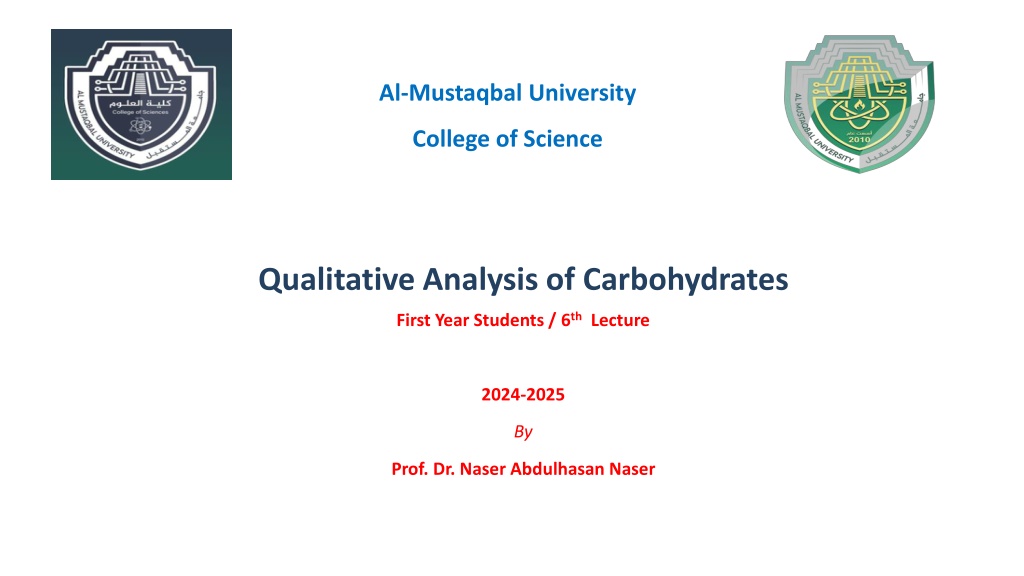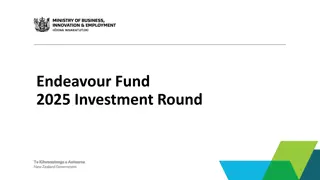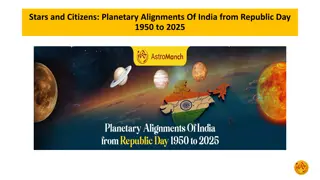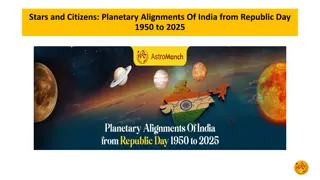
Understanding Carbohydrates: A Comprehensive Guide for First-Year Science Students
Explore the qualitative analysis of carbohydrates in this informative lecture by Prof. Dr. Naser Abdulhasan Naser at Al-Mustaqbal University. Learn about the classification, biological role, and complexity of carbohydrates, as well as their reactivity in living organisms. Discover the essential role carbohydrates play in energy production, structural support, cell communication, and metabolic processes.
Download Presentation

Please find below an Image/Link to download the presentation.
The content on the website is provided AS IS for your information and personal use only. It may not be sold, licensed, or shared on other websites without obtaining consent from the author. Download presentation by click this link. If you encounter any issues during the download, it is possible that the publisher has removed the file from their server.
E N D
Presentation Transcript
Al-Mustaqbal University College of Science Qualitative Analysis of Carbohydrates First Year Students / 6th Lecture 2024-2025 By Prof. Dr. Naser Abdulhasan Naser
Introduction: Carbohydrates, are defined as the polyhydroxy aldehydes or polyhydroxy ketones. Most , but not all carbohydrate have a formula (CH2O)n (hence the name hydrate of carbon). https://encrypted-tbn1.gstatic.com/images?q=tbn:ANd9GcSSWjyAbRi8wObjmP-pgxV8_8kZfxJ_0xVbILK3B5ErdJoRNBU0 In human body, the D-glucose is used. Simple sugars ends with ose. 2
Biological role: Carbohydrates are the key source of energy used by living things. Also serve as extracellular structural elements as in cell wall of bacteria and plant. Carbohydrates are essential macromolecules that support energy production, provide structural support, facilitate cell communication, and contribute to various metabolic processes. Their diverse roles are crucial for maintaining cellular function and overall organism health. 3
Classification of carbohydrates: Several classifications of carbohydrates have proven useful, and are outlined in the following table: 4
Classification based on complexity: Classification based on complexity: 1. Simple sugar (one unit) : Monosaccharides contain one monosaccharide unit. 2. Complex sugar (more than one) : A. Disaccharides contain two monosaccharide units. B. Oligosaccharides contain 3-9 monosaccharide units. C. Polysaccharides can contain more than 9 monosaccharide units. Complex carbohydrates can be broken down into smaller sugar units through a process known as hydrolysis. 5
Classification based on complexity: Classification based on complexity: Disaccharides Monosaccharides Polysaccharides Oligosaccharides 6
Classification based on reactivity: Classification based on reactivity: Reducing and non Reducing sugar : If the oxygen on the anomeric carbon of a sugar is not attached to any other structure, that sugar can act as a reducing agent and is termed a reducing sugar. attached anomeric carbon Non-Reducing sugar FREE anomeric carbon Reducing sugar FREE anomeric carbon Reducing sugar 7
Classification based on reactivity cont: All monosaccharides are reducing sugars; they all have a free reactive carbonyl (C=O) group. Some disaccharides have exposed carbonyl groups and are also reducing sugars like lactose. While other disaccharides such as sucrose are non-reducing sugars and will not react with Benedict's solution. Large polymers of glucose, such as starch, are not reducing sugars. In starch, the glucose units are linked together, and there are no free aldehyde or ketone groups available for reduction reactions. 8
Solubility of sugars [physical property]: Solubility of sugars [physical property]: Monosaccharide and disaccharide can be dissolved freely in water because water is a polar. Polysaccharide cannot be dissolved easily in water, because, it has high molecular weight, which give colloidal solutions in water.(e.g. starch) 10
Chemical properties of carbohydrates: 1 Molisch's Test: To identify the carbohydrate from other macromolecules. 2 Benedict test: For the presence of reducing sugars. Barfoed s Test: To identify the presence of reducing sugars, specifically distinguishing between monosaccharides (which react quickly) and disaccharides (which react more slowly). 3 4 Bial s Test: To distinguish between pentose monosaccharide and hexose monosaccharide (to detect pentoses). 5 Seliwanoff's Test: To distinguish between aldoses and ketoses (to detect ketoses). 12
Experiment 1 : Molisch test Objective: To identify the carbohydrate from other macromolecules lipids and proteins (this test is specific for all carbohydrates). Principle: Two solutions are used : (H2SO4 and -naphthol ) 1. The sulfuric acid (H2SO4) will dehydrates the sugar (pentose to form furfural and dehydrates hexoses to form 5-hydroxymethyl furfural). 2. The dehydrated sugars will further react with -naphthol present in the test reagent to produce a purple product. 13
(1) (2) http://faculty.ksu.edu.sa/27502/picture%20library/Molisch%20Test.JPG -naphthol [Present in the reagent ] Furfural Pentose sugar -naphthol [Present in the reagent ] 5- hydroxymethyl furfural Hexose sugar 14
Experiment 1 : Molisch test Method: Concentrated extremely corrosive and can cause serious burns when not handled properly. sulfuric acid is 1. 2. Two ml of a sample solution is placed in a test tube. 0.5 ml of the Molisch reagent (which -napthol in 95% ethanol) is added. The solution is then poured slowly into a tube containing two ml of concentrated sulfuric acid so that two layers form, producing violet ring appear as liaison between the surface separations. 3. Results: http://faculty.ksu.edu.sa/27502/picture%20library/Molisch%20Test.JPG Tube Observation Glucose Lactose Starch 15
Experiment 2 : Benedict's test Objective: To distinguish between the reducing and non-reducing sugars (to detect the presence of reducing sugar). Principle: The copper sulfate (CuSO4) present in Benedict's solution reacts with electrons from the aldehyde or ketone group of the reducing sugar in alkaline medium. Reducing sugars are oxidized by the copper ion in solution to form a carboxylic acid and a reddish precipitate of copper oxide. The non-reducing sugars give negative result. reddish precipitate reducing sugar carboxylic acid 16
Experiment 2 : Benedict's test Method: 1. 2. 3. 4. One ml of a sample solution is placed in a test tube. Two ml of Benedict's reagent is added. The solution is then heated in a boiling water bath for five minutes. A positive test is indicated by: The formation of a reddish precipitate. Sucrose (-) Glucose (+) Lactose (+) Results: Tube Observation Glucose Lactose Sucrose 17
Experiment 3 : Barfoeds test Objective: To identify the presence of reducing sugars, specifically distinguishing between monosaccharides (which react quickly) and disaccharides (which react more slowly). Principle: Barfoed s test used copper (II) ions in a slightly acidic medium. Reducing saccharides are oxidized by the copper ion in solution to form a carboxylic acid and a reddish precipitate of copper (I) oxide. Different types of reducing sugars react at different rates Reducing monosaccharides react quickly with Barfoed s reagent (acidic condition), but reducing disaccharides react very slowly. The non-reducing sugars give negative result. reddish precipitate reducing sugar carboxylic acid 18
Experiment 3 : Barfoeds test Method: 1. 2. 3. Place one ml of a sample solution in a test tube. Add 3 ml of Barfoed's reagent (a solution of cupric acetate and acetic acid). Heat the solution in a boiling water bath for 6 minutes (after the 3 min check the tubes). Results: Tube Observation Glucose Lactose Starch No Reduction Reduction 19
Experiment Experiment 4 4 : : Bial Bial s s test test Objective: To distinguish between pentose monosaccharide and hexose monosaccharide (to detect pentoses). Principle: Bial's reagent (orcinol, concentrated HCl as a dehydrating acid and ferric chloride as condensation reagent). The test reagent dehydrates pentoses to form furfural, furfural further reacts with orcinol and the iron ion present in the test reagent to produce a bluish or green product. 20
Experiment 4 : Bials test Method: 1. 2. 3. 4. Put 2 ml of a sample solution in a test tube. Add 2 ml of Bial's reagent to each tube. Heat the tubes gently in hot water bath. If the color is not obvious, more water can be added to the tube. Results: Tube Observation Glucose Ribose Glucose (-) Ribose (+) 22
Experiment 5 : Seliwanoff's test Objective: To distinguish between aldoses and ketoses (to detect ketoses). Principle: Seliwanoff s test uses 6M HCl as dehydrating agent and resoncinol as condensation reagent. The test reagent dehydrates ketohexoses to form 5-hydroxymethylfurfural 5-hydroxymethylfurfural further condenses 1. with resorcinol present in the test reagent to produce a cherry red product within two minutes. 2. Aldohexoses react to form the same product. But do so more slowly giving yellow to faint pink color. 23
Experiment 5 : Seliwanoff's test Method: 1. 2. 3. One half ml of a sample solution is placed in a test tube. Two ml of Seliwanoff's reagent (a solution of resorcinol and HCl) is added. The solution is then heated in a boiling water bath for two minutes. Results: Fructose Glucose Tube Observation Glucose fructose 25















